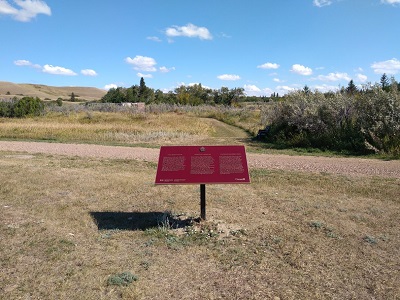Cypress Hills Massacre National Historic Site of Canada
Maple Creek, Saskatchewan

HSMBC plaque
(© Parks Canada | Parcs Canada)
Address :
Maple Creek, Saskatchewan
Recognition Statute:
Historic Sites and Monuments Act (R.S.C., 1985, c. H-4)
Designation Date:
1964-10-27
Dates:
-
1873 to 1873
(Significant)
Event, Person, Organization:
-
Nakoda (Assiniboine) First Nation
(Organization)
Other Name(s):
-
Cypress Hills Massacre
(Designation Name)
Research Report Number:
2004-007, 1964-023, 2004-079
Plaque(s)
Existing plaque: Fort Walsh National Historic Site, Maple Creek, Saskatchewan
Here, on June 1, 1873, American wolf hunters attacked a camp of the Nakoda First Nation, resulting in the massacre of Elders, warriors, women, and children. This hastened the dispatch of the North-West Mounted Police and led to one of the first major tests of Canada’s law enforcement policies in the West. Although the Mounties’ efforts to bring the perpetrators to justice were unsuccessful, they convinced First Nations of the impartiality of the Force and the government it represented. The memory of the massacre and of their fallen ancestors reinforces the connection between the Nakoda people and these lands they hold to be sacred.
Description of Historic Place
Cypress Hills Massacre National Historic Site of Canada is located about 2 km south of Fort Walsh National Historic Site of Canada in a broad valley bottom where American traders attacked a Nakoda camp. The rolling Prairies landscape is broken only by reconstructions of two former trading posts, Farwell’s and Solomon’s, involved in the massacre. The formal recognition refers to the associated landscape and archaeological remains surviving from the debacle on what is now Park’s Canada’s property, although the actual site of the massacre extends beyond these boundaries.
Heritage Value
Cypress Hills Massacre National Historic Site of Canada was designated national historic site of Canada in 1964 because: according to the Nakoda, the site of the Cypress Hills Massacre, where many Nakoda lost their lives, is the place to which their spirits are forever tied. Here the memory and legacy of the massacre victims reach across time to remind how the events that occurred at this location on June 1, 1873 influenced Canadian history; the massacre was one of the first major tests of Canada's law enforcement policies in Western Canada. Ottawa's determination to prosecute crimes against Natives with as much vigour as those against others was important in establishing peaceful relations between Aboriginal peoples of the prairies and the government.
The heritage value of Cypress Hills Massacre National Historic Site of Canada resides in its witness to the event of June 1, 1873 when a group of American “wolfers” attacked the Nakoda camp near Farwell’s and Solomon’s trading posts in a dispute over horses. Value lies in those landscape and archaeological resources associated with the battle, in the setting, and in the spiritual identity of the locations where the remains of those who lost their lives were interred. The Royal Canadian Mounted Police reconstructed Solomon’s and Farwell’s trading posts as a centennial project and Parks Canada conducted selective archaeological investigation of the trading post sites in 1972.
Sources: Historic Sites and Monuments Board of Canada, Minutes, 1964, Spring 2004.
Character-Defining Elements
Key features contributing to the heritage value of this site include: the location near the United States/Canada border; the setting in the rolling Cypress Hills of southwestern Saskatchewan; its site on a valley floor covered by native grasses and shrubs beside a coulee lined by slopes covered with native trees, shrubs, and grasses; the landscape features associated with the massacre, including the grove to which the Nakoda retreated, and the hillside from which the Nakoda launched a counterattack; the archaeological sites associated with the massacre, including the Nakoda campsite, firing positions in their extent and materials; integrity of the gravesites of Nakoda and other casualties of the battle; the archaeological remains of the two trading posts; the viewscapes to other parts of the massacre site not on Parks Canada property; its continued accessibility to those coming to honour the dead.